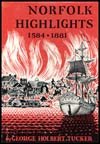Chapter 9
Norfolk Becomes a Borough
Fifty-six years after its establishment as a town by an act of the Virginia Assembly in 1680, Norfolk was created a borough by royal charter on September 15, 1736. The charter was granted and the letters of patent were witnessed by William Gooch, lieutenant governor and commander-in-chief of the Colony and Dominion of Virginia at Williamsburg, in the tenth year of the reign of King George II.
For its governing body, the charter specified that the borough should have "a mayor, one person learned in the law, styled and bearing the office of recorder of the said borough, eight aldermen, and sixteen other persons to be common councilmen."
Samuel Boush I, the "old Colonel Boush" who had "stirred his old bones very cheerfully in our service" when William Byrd II passed through Norfolk in 1728 on his way to act as a Virginia commissioner in the surveying of the boundary line between Virginia and North Carolina, was named in the charter as Norfolk's first mayor. As he died before November 18, 1736, however, the date of the first borough council meeting, George Newton was named mayor in his place.
Norfolk's first recorder, Sir John Randolph (1693-1737), one of the leading Virginians of his day and the only native Virginian to be knighted during the Colonial period, was also sworn in at the same meeting. Incidentally, it was the only one he ever attended, because he appointed Major David Osheal as his deputy immediately after his swearing in.
The eight men who became Norfolk's first aldermen in 1736 were typical of solid citizens who were responsible for the town's pre-Revolutionary prosperity.
George Newton (1678-1762), Norfolk's first active mayor, a son of an earlier George Newton, was educated in England. He was high sherrif and a justice of Norfolk County and a member of the Virginia Assembly at Williamsburg. He was mayor of the borough again in 1742.
Samuel Boush II, called "the younger," was a son of the man who had been named mayor in the borough charter. He was the first clerk of the Norfolk Borough Court.
John Hutchings (1691-1768), a son of Daniel Hutchings, a mariner, and a grandson of John Hutchings of "Pembroke Tribe" Bermuda, succeeded Newton as mayor and was again mayor in 1743 and 1755. He is buried near the south gate of St. Paul's Churchyard.
Robert Tucker II, the oldest son of Robert Tucker I, a wealthy Norfolk merchant who presented the still-preserved London wrought silver chalice and paten to the "Parish Church of Norfolk Towne" at the time of his death in 1722, succeeded Hutchings as mayor in 1738 and was again mayor in 1749 and 1759.
John Taylor (1694-1744), a native of the parish of Fintrie in the County of Sterling, Scotland, was mayor of Norfolk in 1739 and 1744. His handsome armoral tombstone in St. Paul's Churchyard was moved there several years ago from his private graveyard on the site of the present Customs House.
Samuel Smith, the younger, is a bit of an enigma, for when the elder Samuel Smith died in 1739, he referred to him in his will as "my friend Samuel Smith alias Samuel Coverley." In any event, the younger Samuel Smith presented the borough with its first known seal, a silver one with velum wafers, on June 24, 1740.
James Ivy (or Ivey) was also a vestryman of Elizabeth River Parish and a justice of the peace for Norfolk County. When he died in 1752, he saw to it that his widow would not be without firewood by leaving "Unto my loving Wife during her Widdowhood Liberty to Cutt Timber of the land I bought from Mr. John Taylor."
Of Alexander Campbell, little is known except that he was a merchant and owner of vessels and that Campbell's Wharf on the old Norfolk waterfront was named for him.
Chapter
10
The Norfolk Mace
Norfolk Highlights 1584 - 1881

See the "Table of Contents" for links to every chapter in Norfolk Highlights 1584 - 1881 by George Holbert Tucker.
